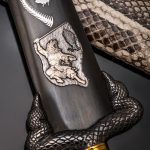Reflecting the ancient Japanese mythical plot and creating its own vision of a legendary and mysterious sword, which legends are composed about, but which no one has ever seen – such a task, no doubt, turned out to be extremely interesting for authors, artists, weapon makers of Zlatoust. The study of the images of the Japanese epic and serpent-fighting myths of other nations, the study of the Zlatoust heritage, including the saber decorated by Ivan Bushuev, in the form of a battle scene of an ancient warrior with a huge serpent, as well as the unique experience of making art damask steel, allowed to create an original sword, named after the hero of the myth – the god of the wind and the storms Susanoo.
The shape of the “Susanoo” sword is fundamentally different from the modern concept of Japanese weapons. The authors took the idea of the mysterious sword Kusanagi as a basis. According to some sources, the legendary sword, which for centuries has been a symbol of the power of the Japanese emperors, was made in the style of weapons of the Bronze Age – straight, double-edged, short. The authorities of Japan never put the mythical sword on public display, even during coronations the sword was carried out wrapped in a canvas. There is no direct evidence for the existence of the mythical sword-symbol, but, as one of the versions, it is stored in one of the shrines of the ancient city of Nagoya. But the more interesting was the task that the authors set themselves.
The “Susanoo” sword symbolizes the eternal struggle of light and darkness and conveys the spirit of victory and the strength of faith of the hero, who dared to engage in battle with a terrible enemy. The authors managed to combine the threads of the past and the present, find the points of intercourse of cultural traditions, fuse the achievements of the Ural masters and Japanese gunsmiths into a single whole and offer their own, original version of the mythical sword.































